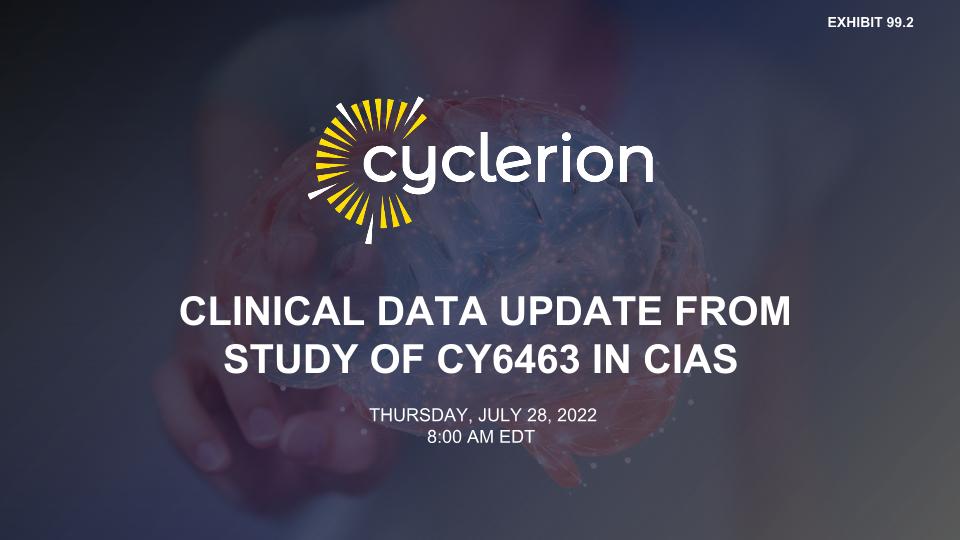
Clinical Data Update from Study of CY6463 in CIAS Thursday, July 28, 2022 8:00 am EDT Exhibit 99.2
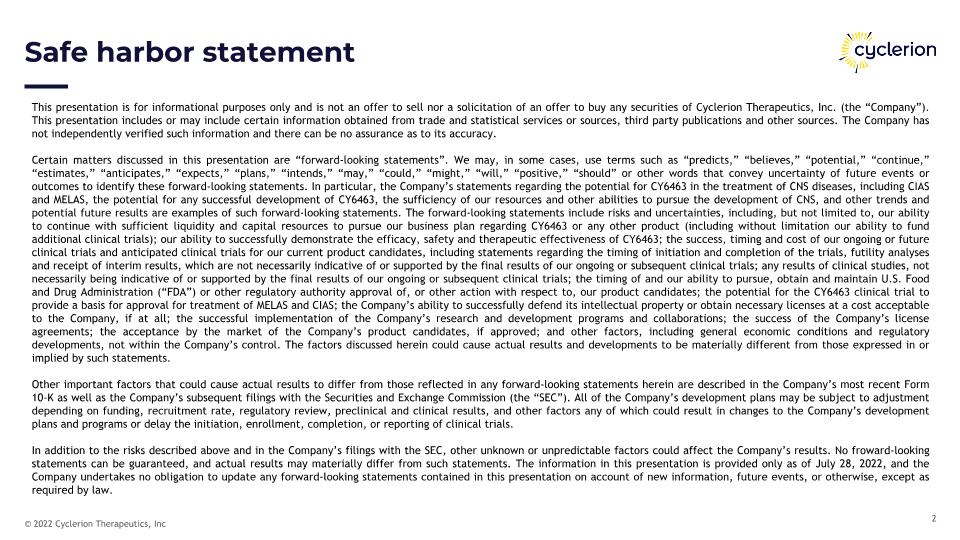
Safe harbor statement This presentation is for informational purposes only and is not an offer to sell nor a solicitation of an offer to buy any securities of Cyclerion Therapeutics, Inc. (the “Company”). This presentation includes or may include certain information obtained from trade and statistical services or sources, third party publications and other sources. The Company has not independently verified such information and there can be no assurance as to its accuracy. Certain matters discussed in this presentation are “forward-looking statements”. We may, in some cases, use terms such as “predicts,” “believes,” “potential,” “continue,” “estimates,” “anticipates,” “expects,” “plans,” “intends,” “may,” “could,” “might,” “will,” “positive,” “should” or other words that convey uncertainty of future events or outcomes to identify these forward-looking statements. In particular, the Company’s statements regarding the potential for CY6463 in the treatment of CNS diseases, including CIAS and MELAS, the potential for any successful development of CY6463, the sufficiency of our resources and other abilities to pursue the development of CNS, and other trends and potential future results are examples of such forward-looking statements. The forward-looking statements include risks and uncertainties, including, but not limited to, our ability to continue with sufficient liquidity and capital resources to pursue our business plan regarding CY6463 or any other product (including without limitation our ability to fund additional clinical trials); our ability to successfully demonstrate the efficacy, safety and therapeutic effectiveness of CY6463; the success, timing and cost of our ongoing or future clinical trials and anticipated clinical trials for our current product candidates, including statements regarding the timing of initiation and completion of the trials, futility analyses and receipt of interim results, which are not necessarily indicative of or supported by the final results of our ongoing or subsequent clinical trials; any results of clinical studies, not necessarily being indicative of or supported by the final results of our ongoing or subsequent clinical trials; the timing of and our ability to pursue, obtain and maintain U.S. Food and Drug Administration (“FDA”) or other regulatory authority approval of, or other action with respect to, our product candidates; the potential for the CY6463 clinical trial to provide a basis for approval for treatment of MELAS and CIAS; the Company’s ability to successfully defend its intellectual property or obtain necessary licenses at a cost acceptable to the Company, if at all; the successful implementation of the Company’s research and development programs and collaborations; the success of the Company’s license agreements; the acceptance by the market of the Company’s product candidates, if approved; and other factors, including general economic conditions and regulatory developments, not within the Company’s control. The factors discussed herein could cause actual results and developments to be materially different from those expressed in or implied by such statements. Other important factors that could cause actual results to differ from those reflected in any forward-looking statements herein are described in the Company’s most recent Form 10-K as well as the Company’s subsequent filings with the Securities and Exchange Commission (the “SEC”). All of the Company’s development plans may be subject to adjustment depending on funding, recruitment rate, regulatory review, preclinical and clinical results, and other factors any of which could result in changes to the Company’s development plans and programs or delay the initiation, enrollment, completion, or reporting of clinical trials. In addition to the risks described above and in the Company’s filings with the SEC, other unknown or unpredictable factors could affect the Company’s results. No froward-looking statements can be guaranteed, and actual results may materially differ from such statements. The information in this presentation is provided only as of July 28, 2022, and the Company undertakes no obligation to update any forward-looking statements contained in this presentation on account of new information, future events, or otherwise, except as required by law.
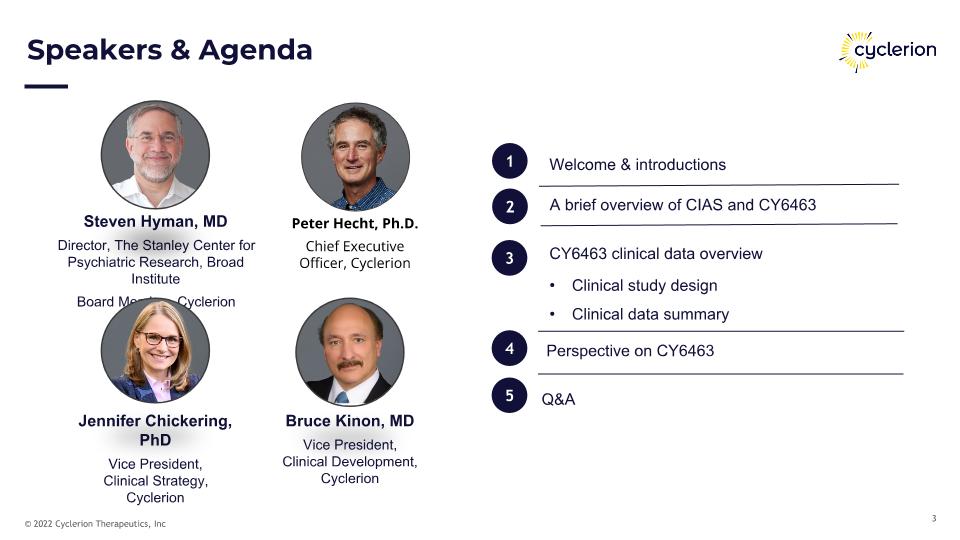
Steven Hyman, MD Director, The Stanley Center for Psychiatric Research, Broad Institute Board Member, Cyclerion Speakers & Agenda 1 Welcome & introductions A brief overview of CIAS and CY6463 CY6463 clinical data overview Clinical study design Clinical data summary Perspective on CY6463 Q&A 2 3 4 5 Jennifer Chickering, PhD Vice President, Clinical Strategy, Cyclerion Bruce Kinon, MD Vice President, Clinical Development, Cyclerion Peter Hecht, Ph.D. Chief Executive Officer, Cyclerion
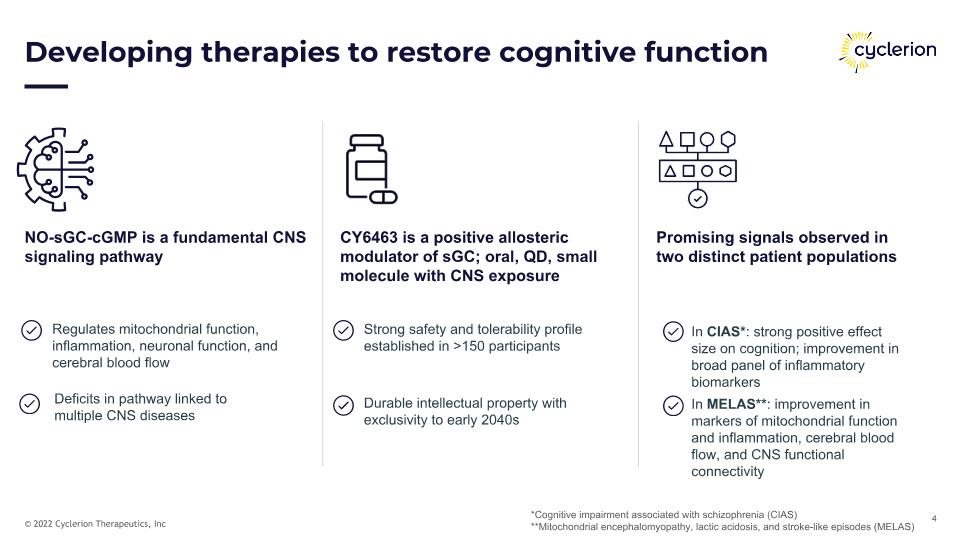
Developing therapies to restore cognitive function NO-sGC-cGMP is a fundamental CNS signaling pathway Regulates mitochondrial function, inflammation, neuronal function, and cerebral blood flow CY6463 is a positive allosteric modulator of sGC; oral, QD, small molecule with CNS exposure Promising signals observed in two distinct patient populations Strong safety and tolerability profile established in >150 participants In MELAS**: improvement in markers of mitochondrial function and inflammation, cerebral blood flow, and CNS functional connectivity In CIAS*: strong positive effect size on cognition; improvement in broad panel of inflammatory biomarkers *Cognitive impairment associated with schizophrenia (CIAS) **Mitochondrial encephalomyopathy, lactic acidosis, and stroke-like episodes (MELAS) Deficits in pathway linked to multiple CNS diseases Durable intellectual property with exclusivity to early 2040s
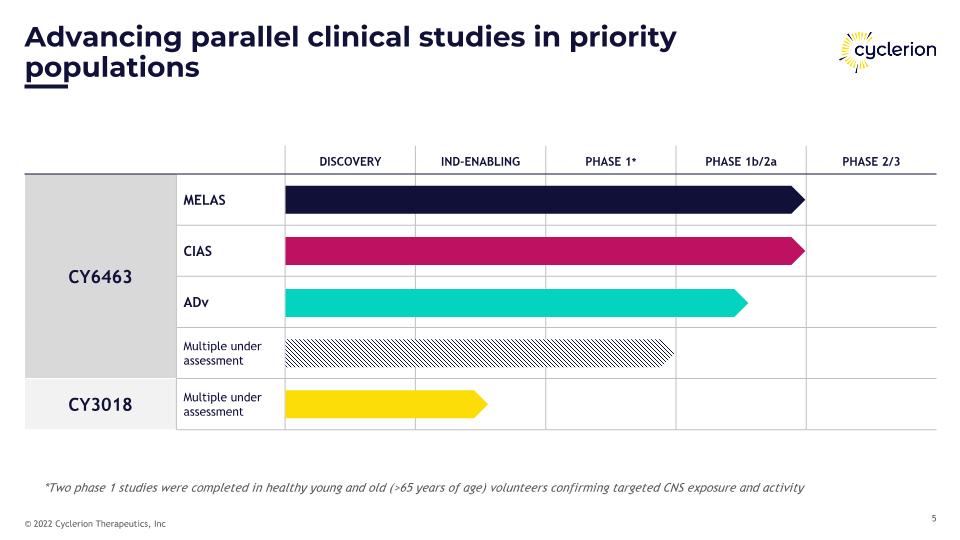
DISCOVERY IND-ENABLING PHASE 1* PHASE 1b/2a PHASE 2/3 CY6463 MELAS CIAS ADv Multiple under assessment CY3018 Multiple under assessment Advancing parallel clinical studies in priority populations *Two phase 1 studies were completed in healthy young and old (>65 years of age) volunteers confirming targeted CNS exposure and activity
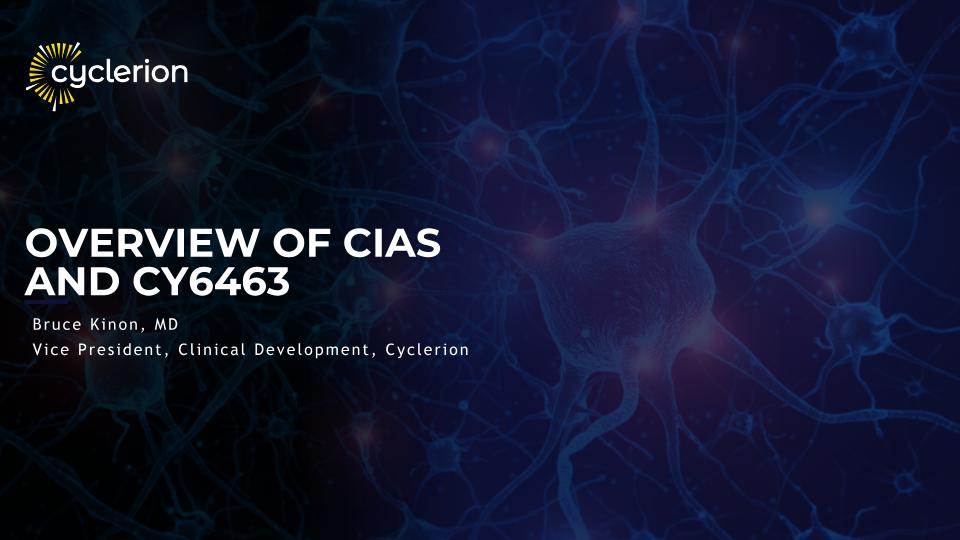
Overview of CIAS And CY6463 Bruce Kinon, MD Vice President, Clinical Development, Cyclerion
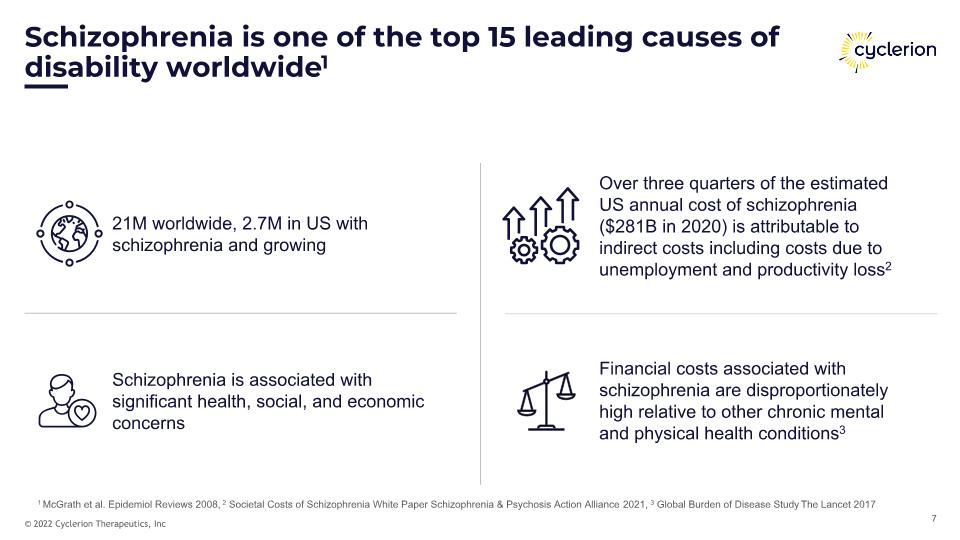
Schizophrenia is one of the top 15 leading causes of disability worldwide1 21M worldwide, 2.7M in US with schizophrenia and growing Schizophrenia is associated with significant health, social, and economic concerns Over three quarters of the estimated US annual cost of schizophrenia ($281B in 2020) is attributable to indirect costs including costs due to unemployment and productivity loss2 Financial costs associated with schizophrenia are disproportionately high relative to other chronic mental and physical health conditions3 1 McGrath et al. Epidemiol Reviews 2008, 2 Societal Costs of Schizophrenia White Paper Schizophrenia & Psychosis Action Alliance 2021, 3 Global Burden of Disease Study The Lancet 2017
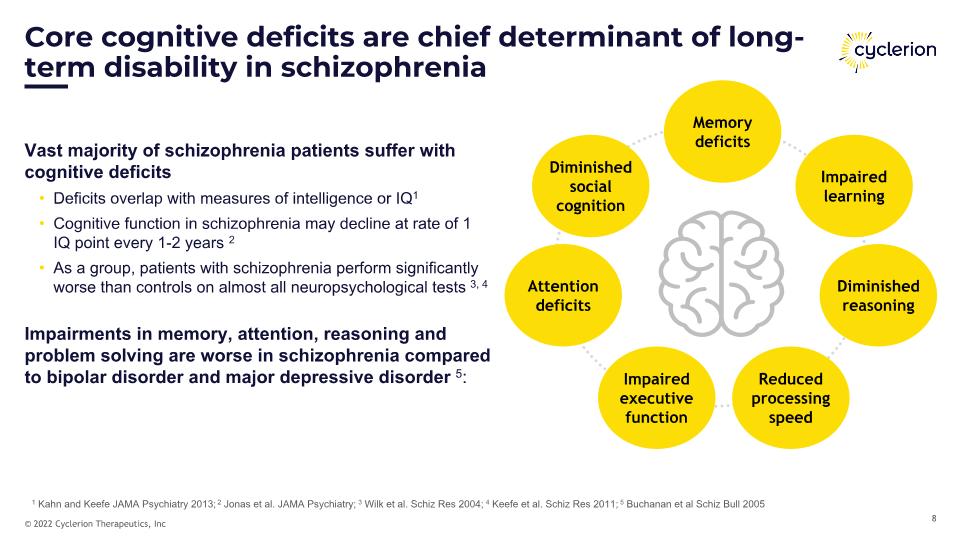
Core cognitive deficits are chief determinant of long-term disability in schizophrenia Vast majority of schizophrenia patients suffer with cognitive deficits Deficits overlap with measures of intelligence or IQ1 Cognitive function in schizophrenia may decline at rate of 1 IQ point every 1-2 years 2 As a group, patients with schizophrenia perform significantly worse than controls on almost all neuropsychological tests 3, 4 Impairments in memory, attention, reasoning and problem solving are worse in schizophrenia compared to bipolar disorder and major depressive disorder 5: 1 Kahn and Keefe JAMA Psychiatry 2013; 2 Jonas et al. JAMA Psychiatry; 3 Wilk et al. Schiz Res 2004; 4 Keefe et al. Schiz Res 2011; 5 Buchanan et al Schiz Bull 2005 Memory deficits Diminished reasoning Diminished social cognition Impaired executive function Impaired learning Reduced processing speed Attention deficits
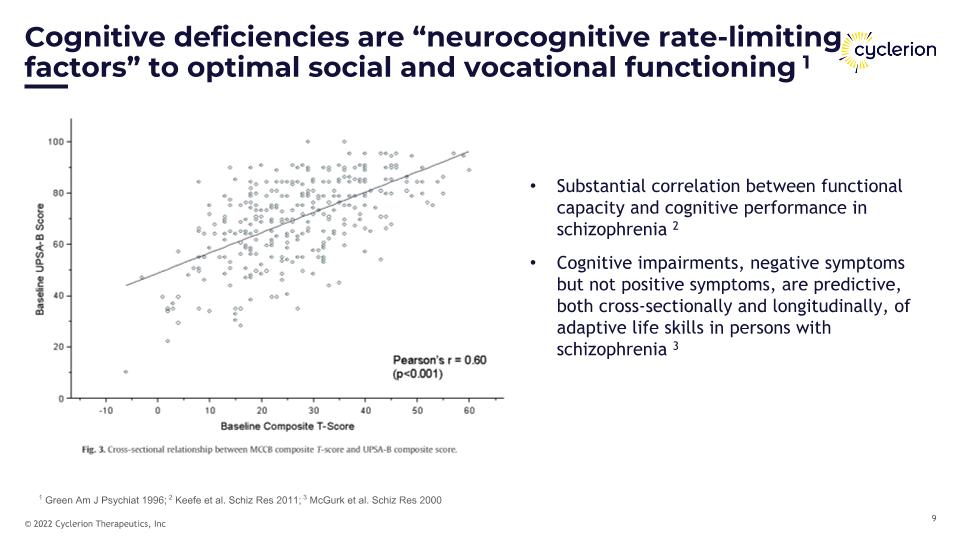
Cognitive deficiencies are “neurocognitive rate-limiting factors” to optimal social and vocational functioning 1 Substantial correlation between functional capacity and cognitive performance in schizophrenia 2 Cognitive impairments, negative symptoms but not positive symptoms, are predictive, both cross-sectionally and longitudinally, of adaptive life skills in persons with schizophrenia 3 1 Green Am J Psychiat 1996; 2 Keefe et al. Schiz Res 2011; 3 McGurk et al. Schiz Res 2000
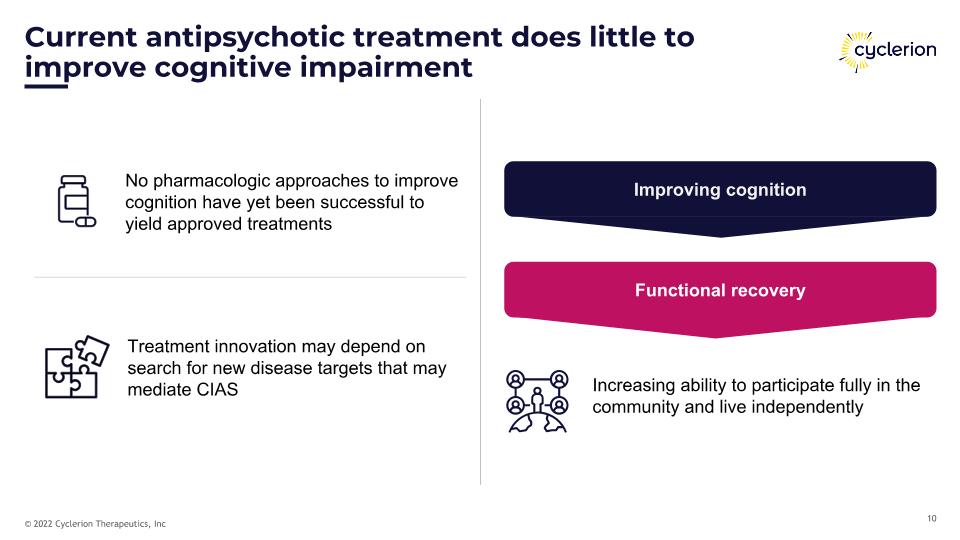
Current antipsychotic treatment does little to improve cognitive impairment No pharmacologic approaches to improve cognition have yet been successful to yield approved treatments Treatment innovation may depend on search for new disease targets that may mediate CIAS Increasing ability to participate fully in the community and live independently Functional recovery Improving cognition
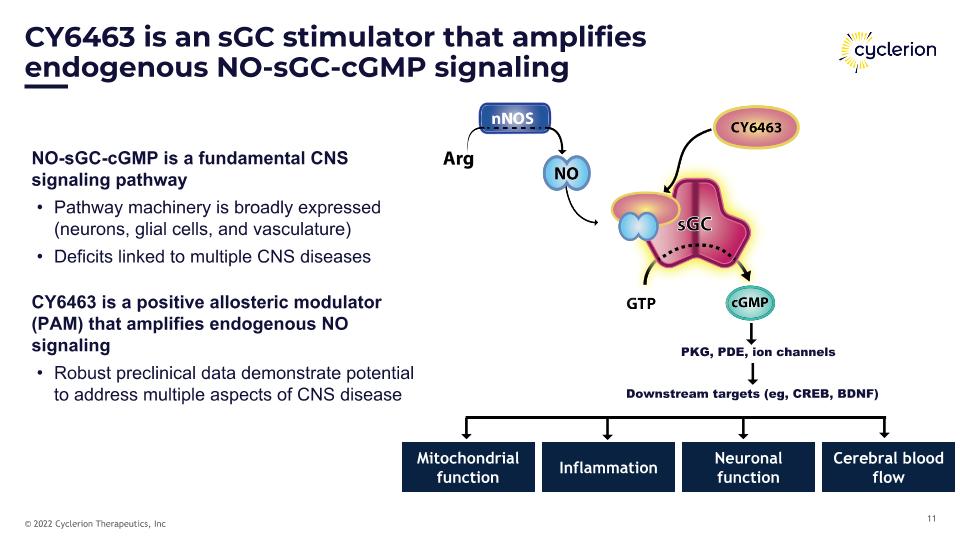
CY6463 is an sGC stimulator that amplifies endogenous NO-sGC-cGMP signaling NO-sGC-cGMP is a fundamental CNS signaling pathway Pathway machinery is broadly expressed (neurons, glial cells, and vasculature) Deficits linked to multiple CNS diseases CY6463 is a positive allosteric modulator (PAM) that amplifies endogenous NO signaling Robust preclinical data demonstrate potential to address multiple aspects of CNS disease Mitochondrial function Inflammation Neuronal function Cerebral blood flow PKG, PDE, ion channels Downstream targets (eg, CREB, BDNF)
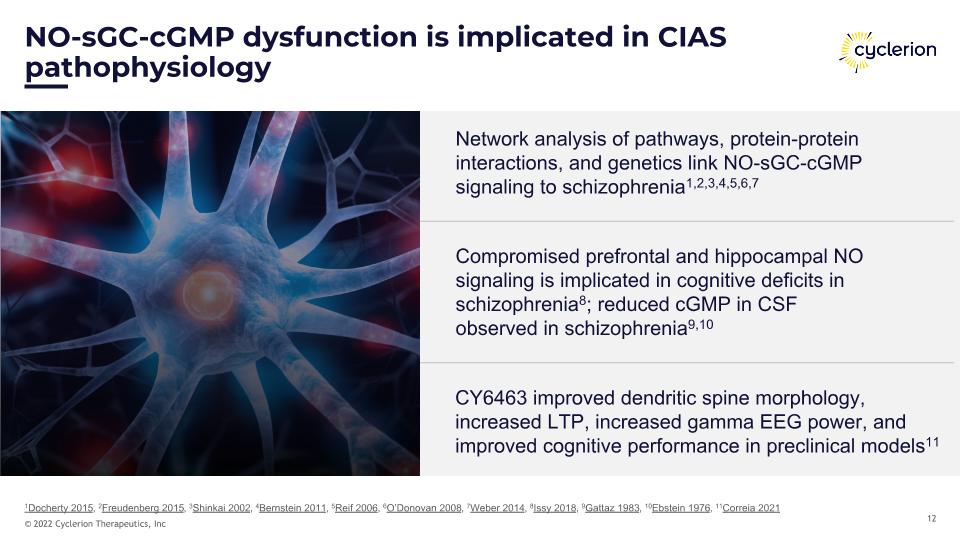
NO-sGC-cGMP dysfunction is implicated in CIAS pathophysiology CY6463 improved dendritic spine morphology, increased LTP, increased gamma EEG power, and improved cognitive performance in preclinical models11 Compromised prefrontal and hippocampal NO signaling is implicated in cognitive deficits in schizophrenia8; reduced cGMP in CSF observed in schizophrenia9,10 Network analysis of pathways, protein-protein interactions, and genetics link NO-sGC-cGMP signaling to schizophrenia1,2,3,4,5,6,7 1Docherty 2015, 2Freudenberg 2015, 3Shinkai 2002, 4Bernstein 2011, 5Reif 2006, 6O’Donovan 2008, 7Weber 2014, 8Issy 2018, 9Gattaz 1983, 10Ebstein 1976, 11Correia 2021
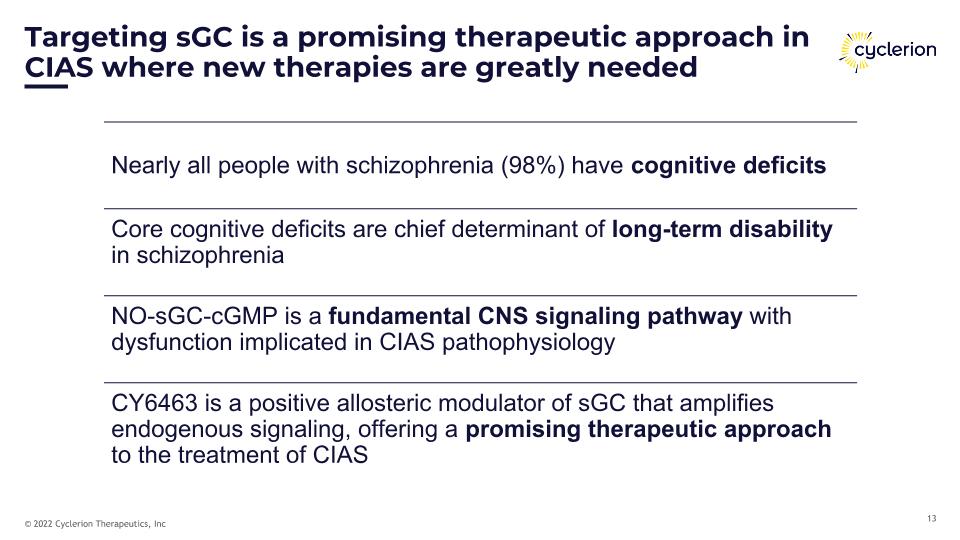
Targeting sGC is a promising therapeutic approach in CIAS where new therapies are greatly needed 0 +0.6 +0.2 +0.4 Nearly all people with schizophrenia (98%) have cognitive deficits Core cognitive deficits are chief determinant of long-term disability in schizophrenia NO-sGC-cGMP is a fundamental CNS signaling pathway with dysfunction implicated in CIAS pathophysiology CY6463 is a positive allosteric modulator of sGC that amplifies endogenous signaling, offering a promising therapeutic approach to the treatment of CIAS
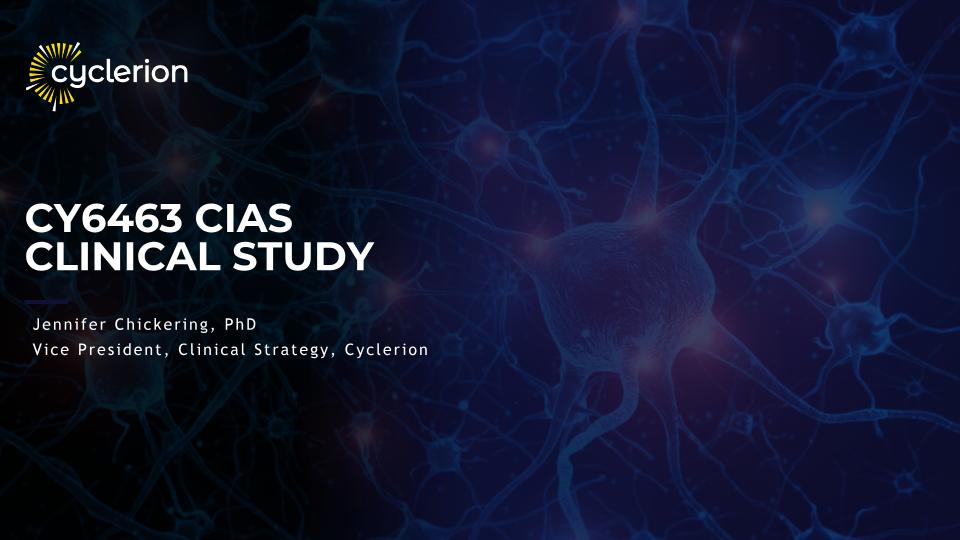
CY6463 CIAS Clinical study Jennifer Chickering, PhD Vice President, Clinical Strategy, Cyclerion
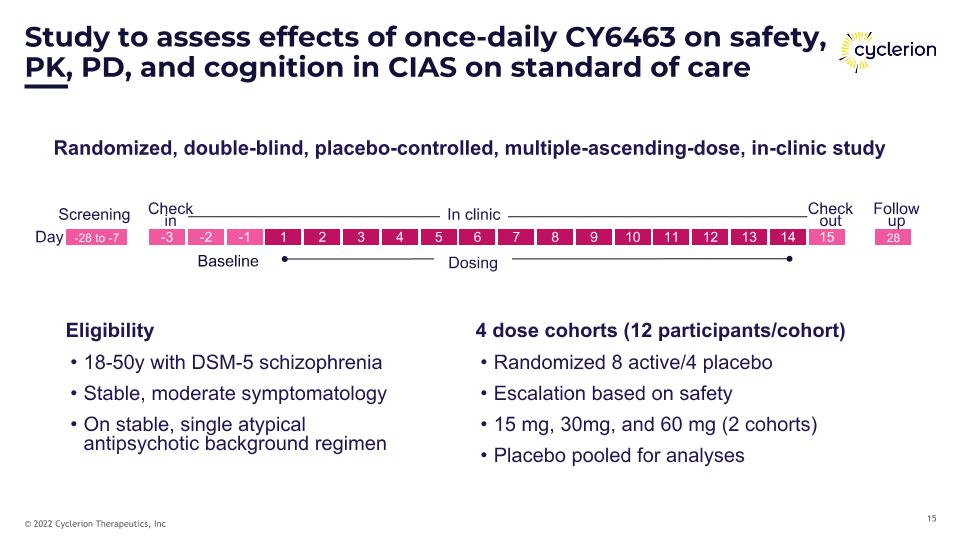
Study to assess effects of once-daily CY6463 on safety, PK, PD, and cognition in CIAS on standard of care In clinic 1 2 3 4 5 9 10 11 12 13 14 -3 -2 -1 15 -28 to -7 28 Screening Check in Check out Follow up Dosing 6 7 8 Day Randomized, double-blind, placebo-controlled, multiple-ascending-dose, in-clinic study Eligibility 18-50y with DSM-5 schizophrenia Stable, moderate symptomatology On stable, single atypical antipsychotic background regimen Baseline 4 dose cohorts (12 participants/cohort) Randomized 8 active/4 placebo Escalation based on safety 15 mg, 30mg, and 60 mg (2 cohorts) Placebo pooled for analyses
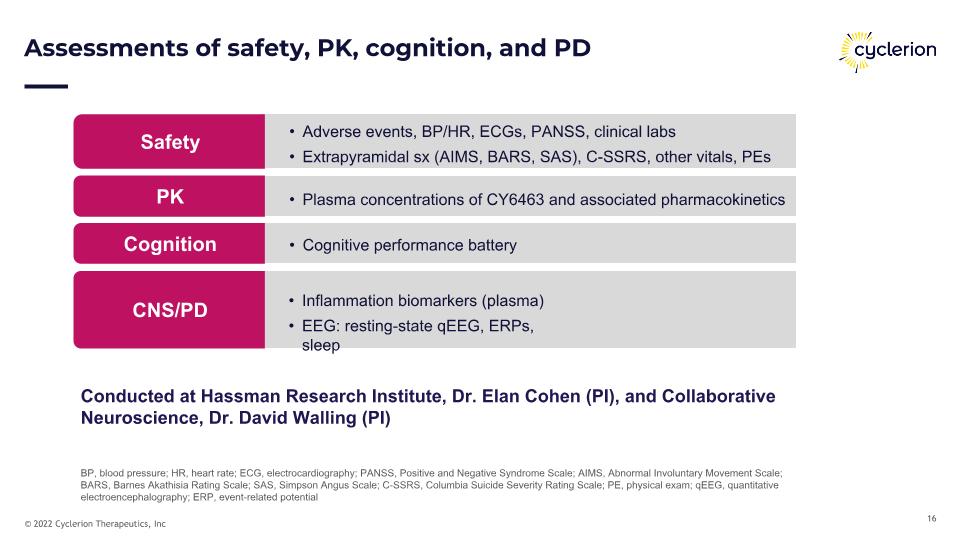
Assessments of safety, PK, cognition, and PD CNS/PD Safety Adverse events, BP/HR, ECGs, PANSS, clinical labs Extrapyramidal sx (AIMS, BARS, SAS), C-SSRS, other vitals, PEs PK Plasma concentrations of CY6463 and associated pharmacokinetics Cognitive performance battery Cognition Inflammation biomarkers (plasma) EEG: resting-state qEEG, ERPs, sleep BP, blood pressure; HR, heart rate; ECG, electrocardiography; PANSS, Positive and Negative Syndrome Scale; AIMS, Abnormal Involuntary Movement Scale; BARS, Barnes Akathisia Rating Scale; SAS, Simpson Angus Scale; C-SSRS, Columbia Suicide Severity Rating Scale; PE, physical exam; qEEG, quantitative electroencephalography; ERP, event-related potential Conducted at Hassman Research Institute, Dr. Elan Cohen (PI), and Collaborative Neuroscience, Dr. David Walling (PI)
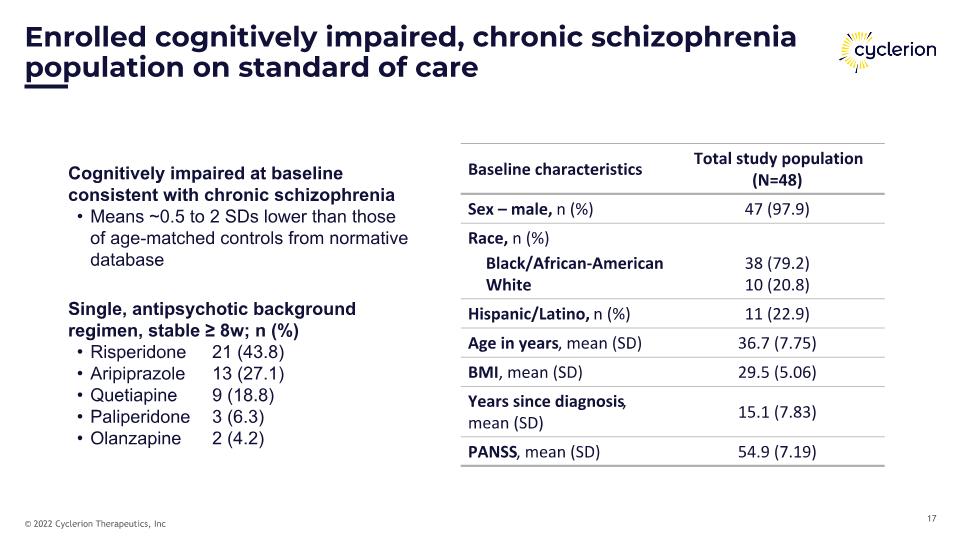
Enrolled cognitively impaired, chronic schizophrenia population on standard of care Baseline characteristics Total study population (N=48) Sex – male, n (%) 47 (97.9) Race, n (%) Black/African-American 38 (79.2) White 10 (20.8) Hispanic/Latino, n (%) 11 (22.9) Age in years, mean (SD) 36.7 (7.75) BMI, mean (SD) 29.5 (5.06) Years since diagnosis, mean (SD) 15.1 (7.83) PANSS, mean (SD) 54.9 (7.19) Cognitively impaired at baseline consistent with chronic schizophrenia Means ~0.5 to 2 SDs lower than those of age-matched controls from normative database Single, antipsychotic background regimen, stable ≥ 8w; n (%) Risperidone 21 (43.8) Aripiprazole 13 (27.1) Quetiapine 9 (18.8) Paliperidone 3 (6.3) Olanzapine 2 (4.2)
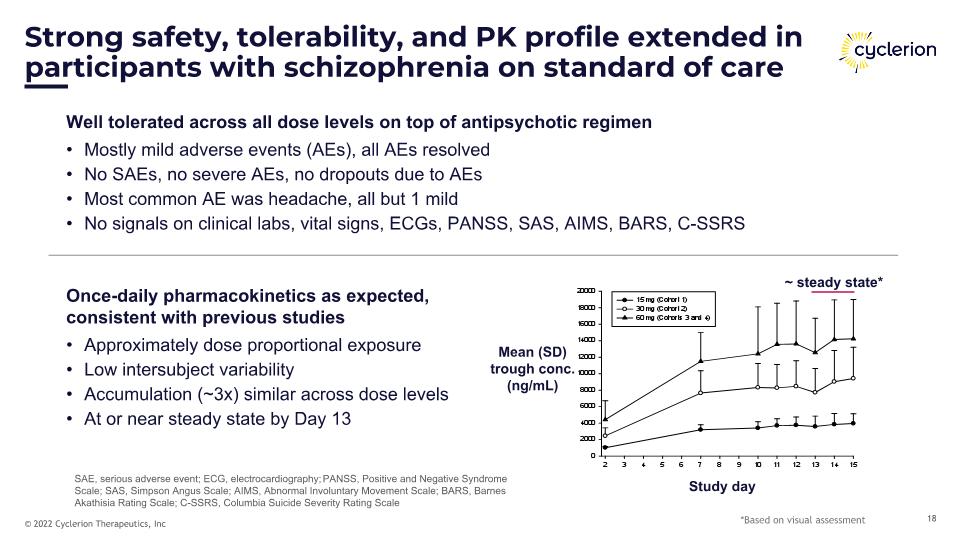
Strong safety, tolerability, and PK profile extended in participants with schizophrenia on standard of care Well tolerated across all dose levels on top of antipsychotic regimen Mostly mild adverse events (AEs), all AEs resolved No SAEs, no severe AEs, no dropouts due to AEs Most common AE was headache, all but 1 mild No signals on clinical labs, vital signs, ECGs, PANSS, SAS, AIMS, BARS, C-SSRS Once-daily pharmacokinetics as expected, consistent with previous studies Approximately dose proportional exposure Low intersubject variability Accumulation (~3x) similar across dose levels At or near steady state by Day 13 *Based on visual assessment ~ steady state* Mean (SD) trough conc. (ng/mL) Study day SAE, serious adverse event; ECG, electrocardiography; PANSS, Positive and Negative Syndrome Scale; SAS, Simpson Angus Scale; AIMS, Abnormal Involuntary Movement Scale; BARS, Barnes Akathisia Rating Scale; C-SSRS, Columbia Suicide Severity Rating Scale
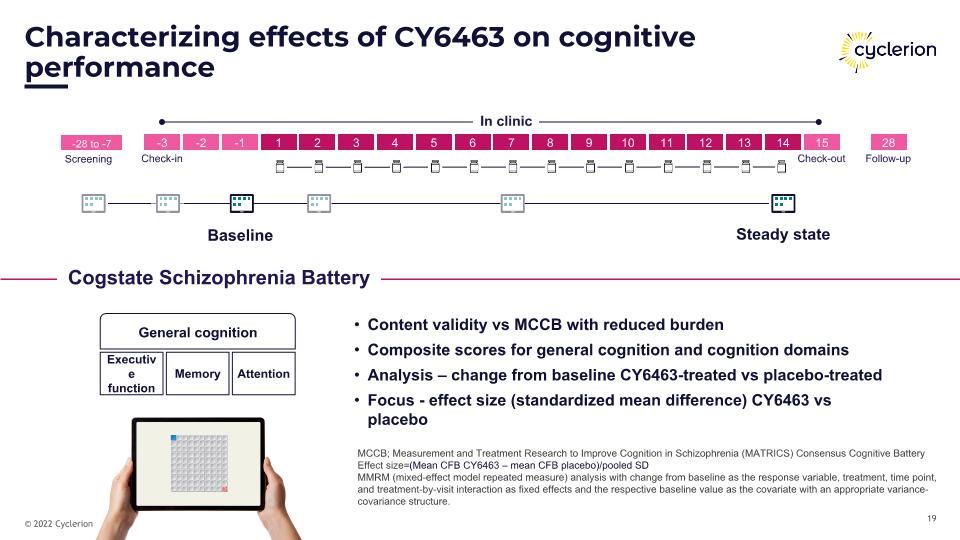
Characterizing effects of CY6463 on cognitive performance In clinic 1 2 3 4 5 9 10 11 12 13 14 -3 -2 -1 15 -28 to -7 28 Screening Check-in Check-out Follow-up 6 7 8 MCCB; Measurement and Treatment Research to Improve Cognition in Schizophrenia (MATRICS) Consensus Cognitive Battery Effect size=(Mean CFB CY6463 – mean CFB placebo)/pooled SD MMRM (mixed-effect model repeated measure) analysis with change from baseline as the response variable, treatment, time point, and treatment-by-visit interaction as fixed effects and the respective baseline value as the covariate with an appropriate variance-covariance structure. Baseline Steady state Content validity vs MCCB with reduced burden Composite scores for general cognition and cognition domains Analysis – change from baseline CY6463-treated vs placebo-treated Focus - effect size (standardized mean difference) CY6463 vs placebo Executive function Attention Memory General cognition Cogstate Schizophrenia Battery
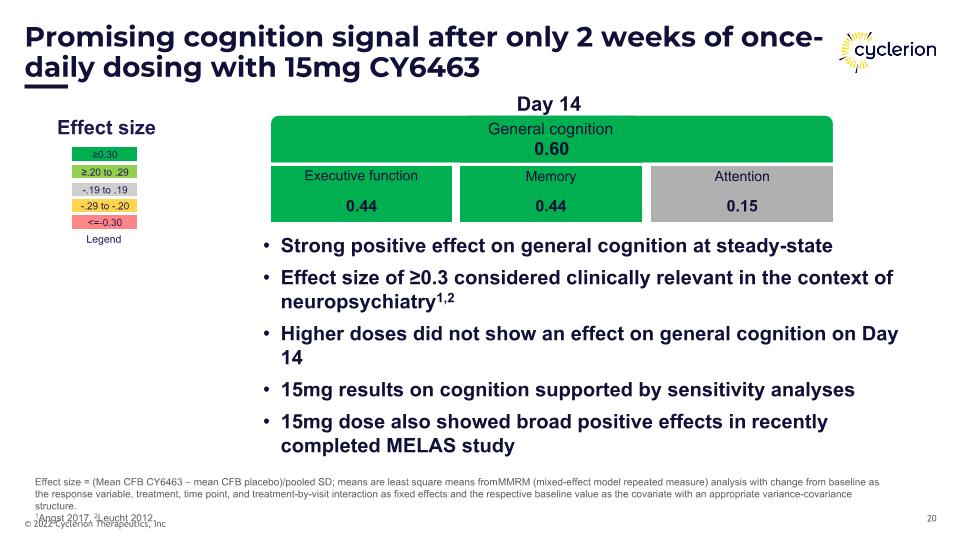
Promising cognition signal after only 2 weeks of once-daily dosing with 15mg CY6463 0.44 0.15 0.44 Attention 0.60 Executive function 0.44 Memory 0.60 General cognition Day 14 Effect size = (Mean CFB CY6463 – mean CFB placebo)/pooled SD; means are least square means from MMRM (mixed-effect model repeated measure) analysis with change from baseline as the response variable, treatment, time point, and treatment-by-visit interaction as fixed effects and the respective baseline value as the covariate with an appropriate variance-covariance structure.�1Angst 2017, 2Leucht 2012. Strong positive effect on general cognition at steady-state Effect size of ≥0.3 considered clinically relevant in the context of neuropsychiatry1,2 Higher doses did not show an effect on general cognition on Day 14 15mg results on cognition supported by sensitivity analyses 15mg dose also showed broad positive effects in recently completed MELAS study Effect size ≥0.30 ≥.20 to .29 -.19 to .19 -.29 to -.20 <=-0.30 Legend
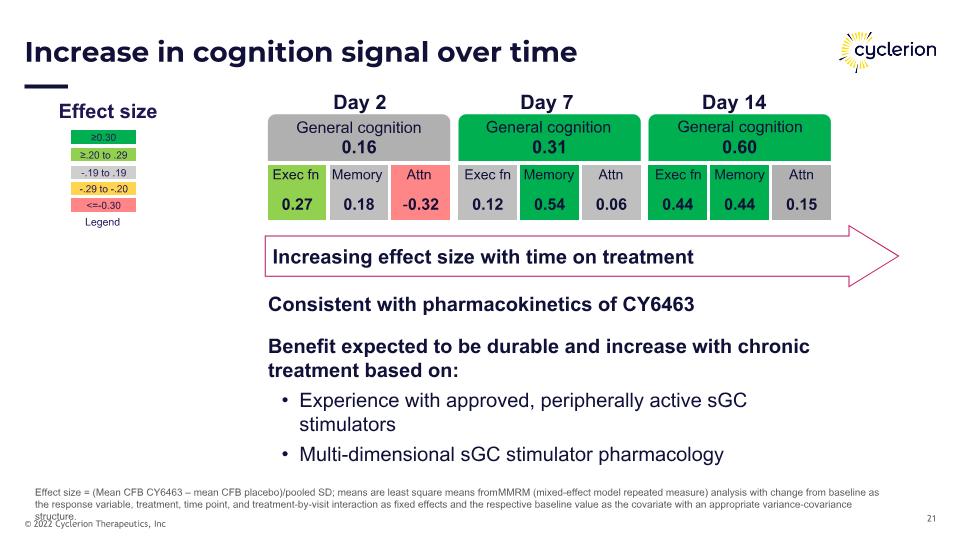
Increase in cognition signal over time Increasing effect size with time on treatment Consistent with pharmacokinetics of CY6463 Benefit expected to be durable and increase with chronic treatment based on: Experience with approved, peripherally active sGC stimulators Multi-dimensional sGC stimulator pharmacology 0.44 0.15 0.44 Exec fn Memory Attn 0.60 General cognition Day 14 0.27 -0.32 0.18 Exec fn Memory Attn 0.16 Day 2 0.12 0.06 0.54 Exec fn Memory Attn 0.31 General cognition Day 7 General cognition Effect size = (Mean CFB CY6463 – mean CFB placebo)/pooled SD; means are least square means from MMRM (mixed-effect model repeated measure) analysis with change from baseline as the response variable, treatment, time point, and treatment-by-visit interaction as fixed effects and the respective baseline value as the covariate with an appropriate variance-covariance structure. Effect size ≥0.30 ≥.20 to .29 -.19 to .19 -.29 to -.20 <=-0.30 Legend
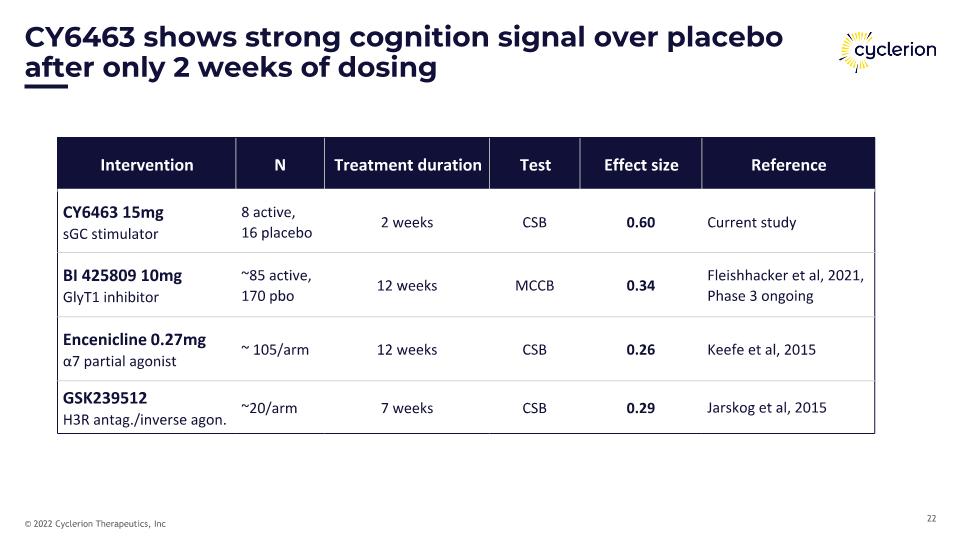
CY6463 shows strong cognition signal over placebo after only 2 weeks of dosing Intervention N Treatment duration Test Effect size Reference CY6463 15mg sGC stimulator 8 active, �16 placebo 2 weeks CSB 0.60 Current study BI 425809 10mg GlyT1 inhibitor ~85 active, 170 pbo 12 weeks MCCB 0.34 Fleishhacker et al, 2021, Phase 3 ongoing Encenicline 0.27mg �α7 partial agonist ~ 105/arm 12 weeks CSB 0.26 Keefe et al, 2015 GSK239512 H3R antag./inverse agon. ~20/arm 7 weeks CSB 0.29 Jarskog et al, 2015
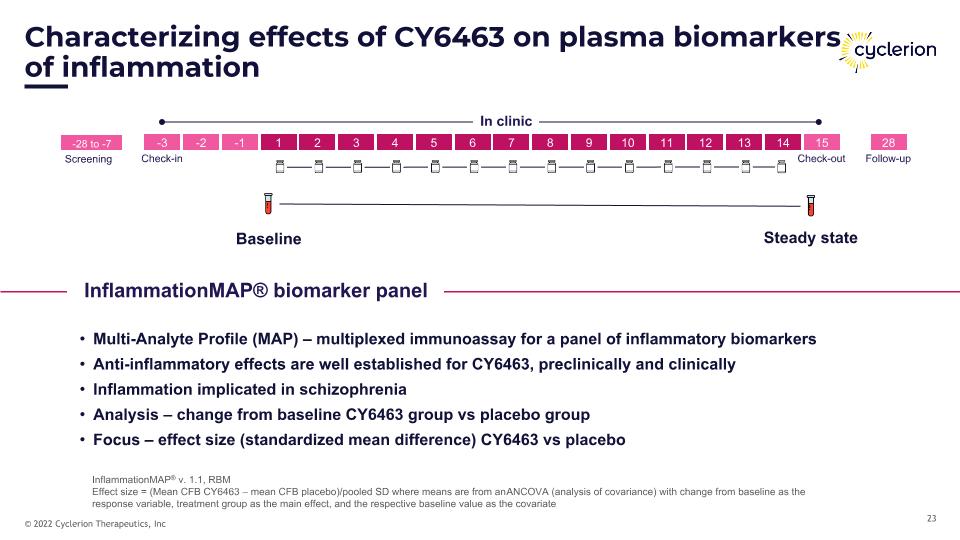
Characterizing effects of CY6463 on plasma biomarkers of inflammation In clinic 1 2 3 4 5 9 10 11 12 13 14 -3 -2 -1 15 -28 to -7 28 Screening Check-in Check-out Follow-up 6 7 8 InflammationMAP® v. 1.1, RBM�Effect size = (Mean CFB CY6463 – mean CFB placebo)/pooled SD where means are from an ANCOVA (analysis of covariance) with change from baseline as the response variable, treatment group as the main effect, and the respective baseline value as the covariate Baseline Steady state Multi-Analyte Profile (MAP) – multiplexed immunoassay for a panel of inflammatory biomarkers Anti-inflammatory effects are well established for CY6463, preclinically and clinically Inflammation implicated in schizophrenia Analysis – change from baseline CY6463 group vs placebo group Focus – effect size (standardized mean difference) CY6463 vs placebo InflammationMAP® biomarker panel
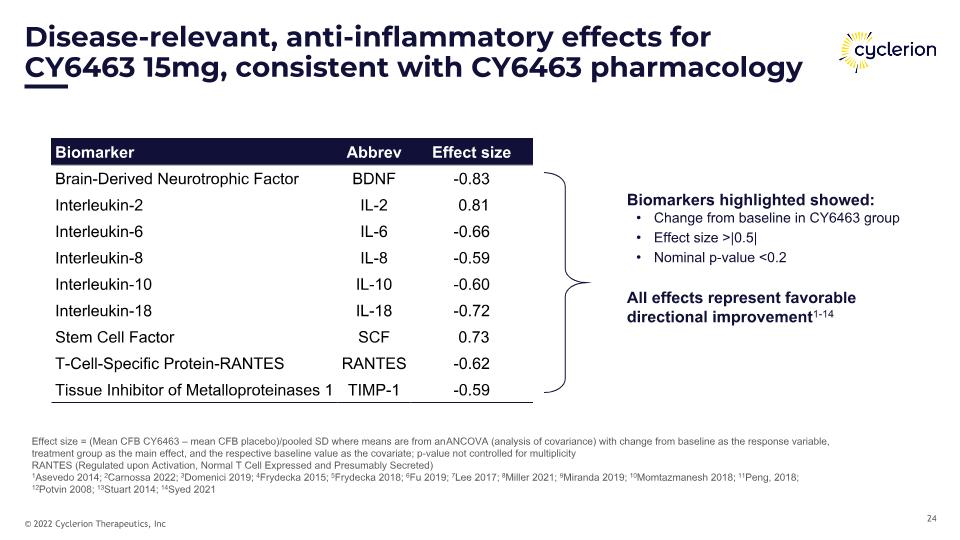
Disease-relevant, anti-inflammatory effects for CY6463 15mg, consistent with CY6463 pharmacology Effect size = (Mean CFB CY6463 – mean CFB placebo)/pooled SD where means are from an ANCOVA (analysis of covariance) with change from baseline as the response variable, treatment group as the main effect, and the respective baseline value as the covariate; p-value not controlled for multiplicity�RANTES (Regulated upon Activation, Normal T Cell Expressed and Presumably Secreted) 1Asevedo 2014; 2Carnossa 2022; 3Domenici 2019; 4Frydecka 2015; 5Frydecka 2018; 6Fu 2019; 7Lee 2017; 8Miller 2021; 9Miranda 2019; 10Momtazmanesh 2018; 11Peng, 2018; 12Potvin 2008; 13Stuart 2014; 14Syed 2021 Biomarker Abbrev Effect size Brain-Derived Neurotrophic Factor BDNF -0.83 Interleukin-2 IL-2 0.81 Interleukin-6 IL-6 -0.66 Interleukin-8 IL-8 -0.59 Interleukin-10 IL-10 -0.60 Interleukin-18 IL-18 -0.72 Stem Cell Factor SCF 0.73 T-Cell-Specific Protein-RANTES RANTES -0.62 Tissue Inhibitor of Metalloproteinases 1 TIMP-1 -0.59 Biomarkers highlighted showed: Change from baseline in CY6463 group Effect size >|0.5| Nominal p-value <0.2 All effects represent favorable directional improvement1-14
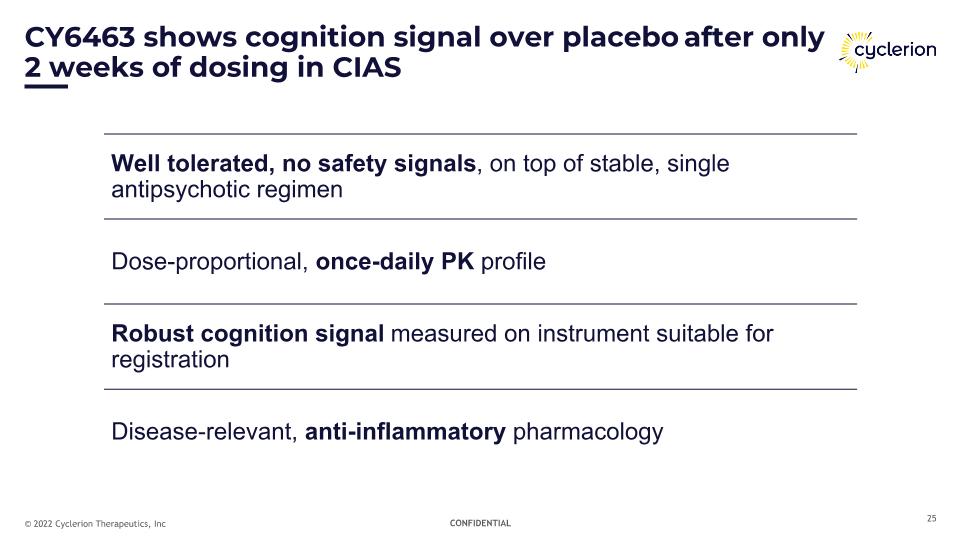
CY6463 shows cognition signal over placebo after only 2 weeks of dosing in CIAS 0 +0.6 +0.2 +0.4 Well tolerated, no safety signals, on top of stable, single antipsychotic regimen Dose-proportional, once-daily PK profile Robust cognition signal measured on instrument suitable for registration Disease-relevant, anti-inflammatory pharmacology
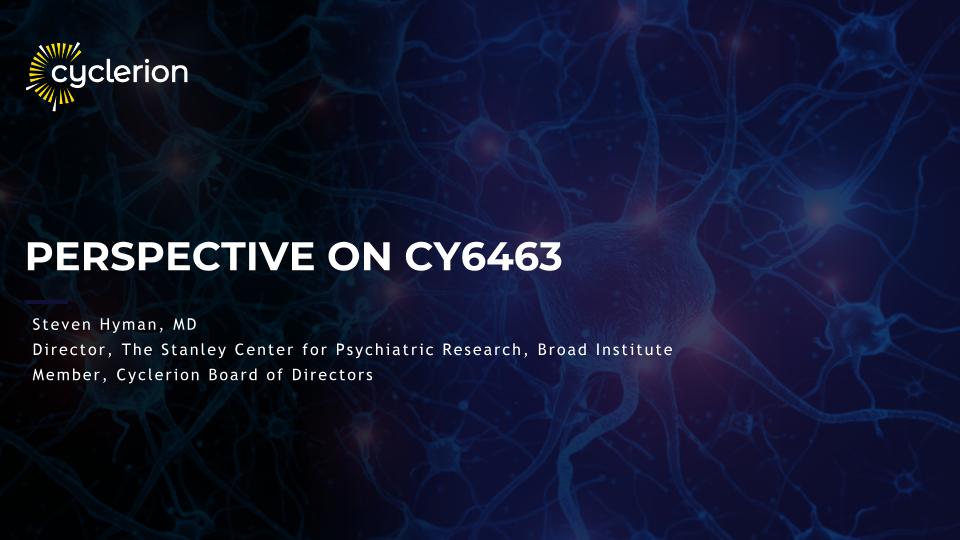
Perspective on CY6463 Steven Hyman, MD Director, The Stanley Center for Psychiatric Research, Broad Institute Member, Cyclerion Board of Directors
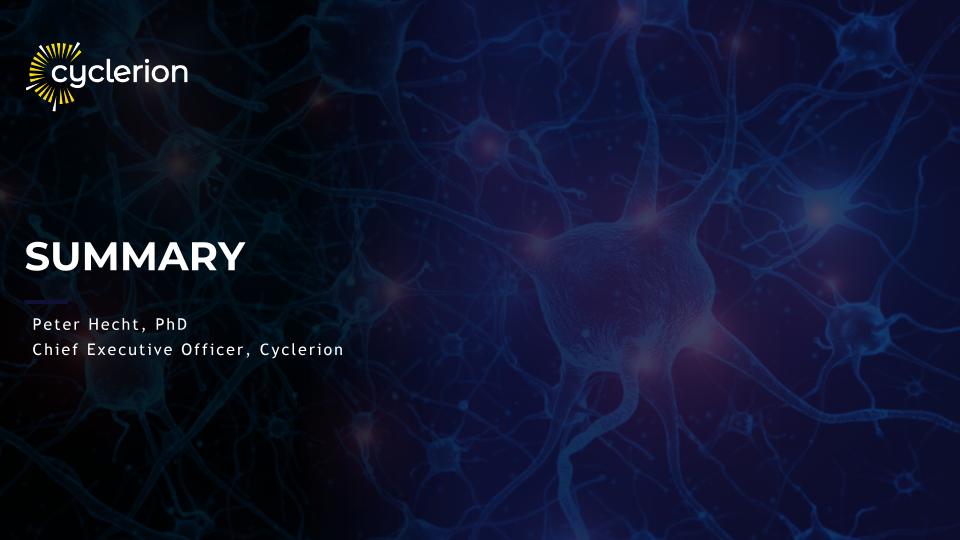
summary Peter Hecht, PhD Chief Executive Officer, Cyclerion
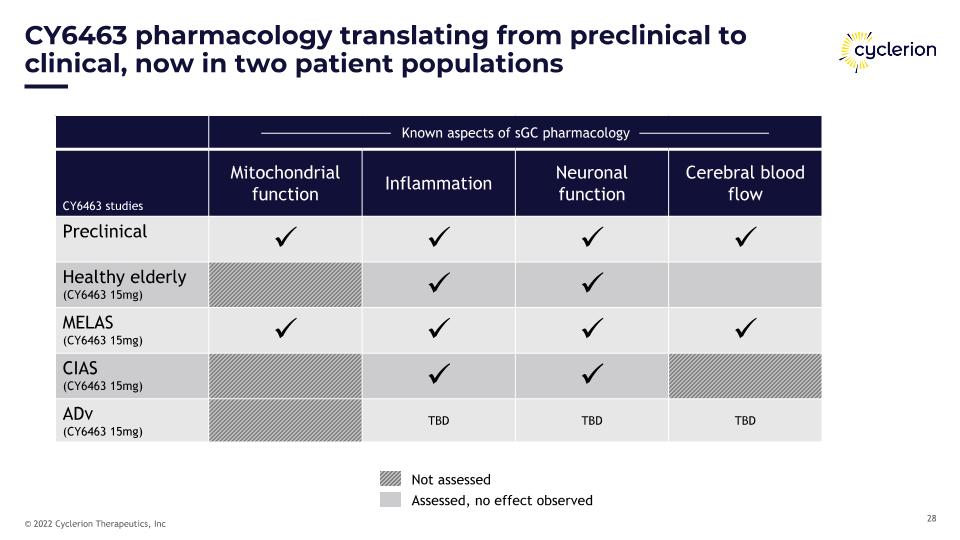
CY6463 pharmacology translating from preclinical to clinical, now in two patient populations Known aspects of sGC pharmacology CY6463 studies Mitochondrial function Inflammation Neuronal function Cerebral blood flow Preclinical Healthy elderly (CY6463 15mg) MELAS (CY6463 15mg) CIAS (CY6463 15mg) ADv (CY6463 15mg) TBD TBD TBD Not assessed Assessed, no effect observed
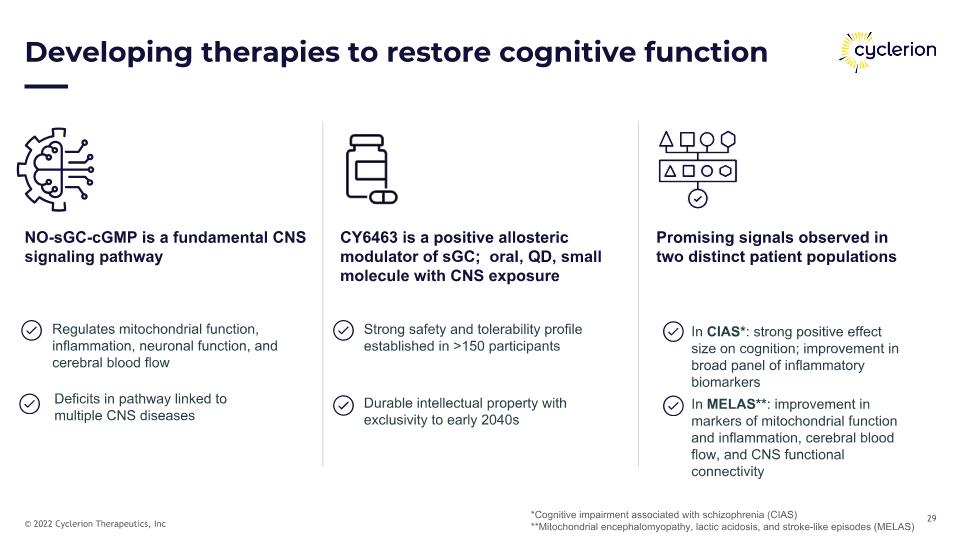
Developing therapies to restore cognitive function NO-sGC-cGMP is a fundamental CNS signaling pathway Regulates mitochondrial function, inflammation, neuronal function, and cerebral blood flow CY6463 is a positive allosteric modulator of sGC; oral, QD, small molecule with CNS exposure Promising signals observed in two distinct patient populations Strong safety and tolerability profile established in >150 participants In MELAS**: improvement in markers of mitochondrial function and inflammation, cerebral blood flow, and CNS functional connectivity In CIAS*: strong positive effect size on cognition; improvement in broad panel of inflammatory biomarkers *Cognitive impairment associated with schizophrenia (CIAS) **Mitochondrial encephalomyopathy, lactic acidosis, and stroke-like episodes (MELAS) Deficits in pathway linked to multiple CNS diseases Durable intellectual property with exclusivity to early 2040s
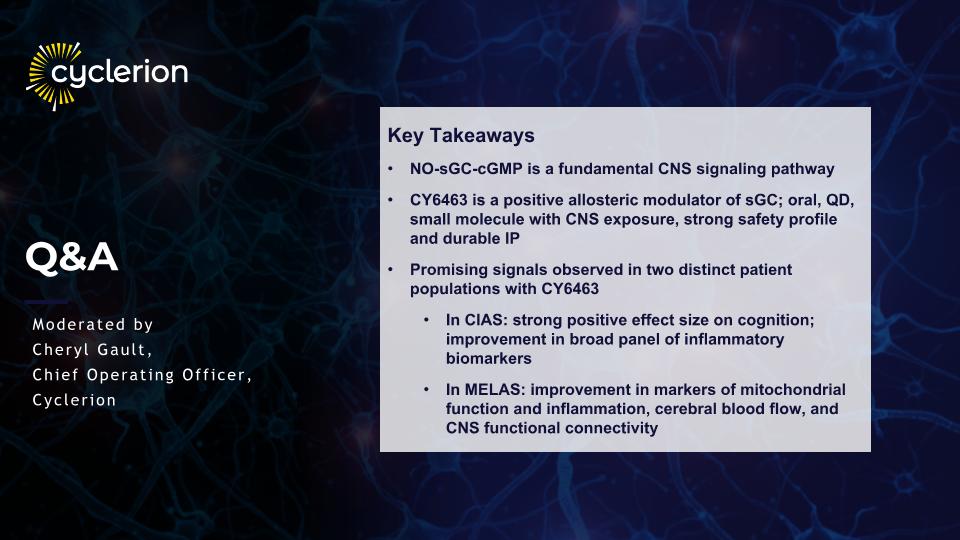
Q&A Moderated by Cheryl Gault, Chief Operating Officer, Cyclerion Key Takeaways NO-sGC-cGMP is a fundamental CNS signaling pathway CY6463 is a positive allosteric modulator of sGC; oral, QD, small molecule with CNS exposure, strong safety profile and durable IP Promising signals observed in two distinct patient populations with CY6463 In CIAS: strong positive effect size on cognition; improvement in broad panel of inflammatory biomarkers In MELAS: improvement in markers of mitochondrial function and inflammation, cerebral blood flow, and CNS functional connectivity





























